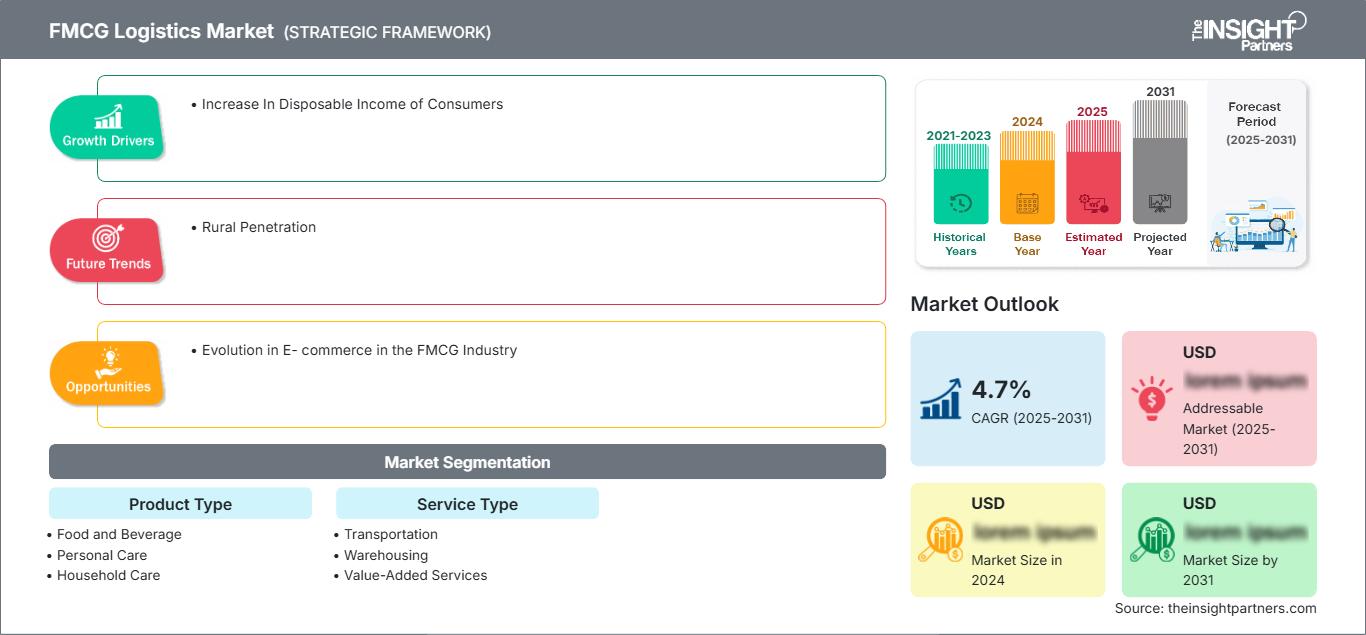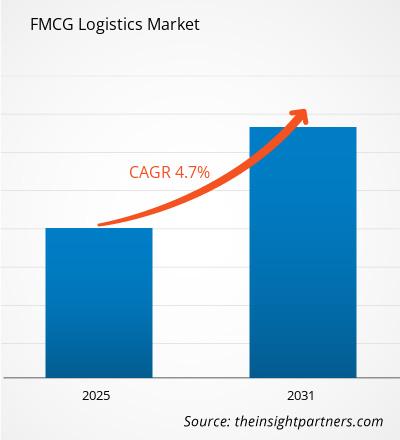FMCG 물류 시장은 2023년부터 2031년까지 연평균 4.7%의 성장률을 기록할 것으로 예상됩니다. FMCG 산업의 전자상거래는 진화하고 있으며, FMCG 물류 시장 또한 성장 추세를 보일 것으로 예상됩니다.
FMCG 물류 시장 분석
FMCG 물류 산업은 급속한 성장을 거듭해 왔습니다. 이는 전자상거래의 발전, 소비자의 선호도 및 수요 변화, 가처분소득 증가, 라이프스타일 및 도시화의 변화, 인구 증가 등 몇 가지 주요 요인의 영향을 받습니다. 이로 인해 공급업체에서 최종 소비자까지 효율적인 배송 기대치를 충족하는 효율적이고 간소화된 물류 솔루션에 대한 수요가 증가하고 있습니다. 소비자들은 인근 오프라인 매장과 온라인 소매업체에서 제품 및 서비스를 이용할 수 있기를 기대합니다. 빠르게 움직이는 소비재 제조업체들은 빠른 배송 및 매장 배송을 제공하는 물류 업체에 의존합니다. 여기에는 공급망, 재고 관리, 유통망의 민첩성, 체계적인 창고 관리 시스템, 수요 예측, 그리고 부가가치 서비스 등 모든 활동이 포함되며, 최소한의 비용으로 제품의 신선도와 품질을 보장하면서 끊임없이 변화하는 고객 수요를 충족합니다.
FMCG 물류 시장 개요
FMCG 물류 부문은 빠르게 변화하는 세상에서 소비자와 기업 모두의 기대를 충족하기 위해 끊임없이 변화하고 있습니다. 끊임없이 변화하는 소비자 수요에 발맞춰 FMCG 물류 산업은 경쟁력을 유지하기 위해 효율성과 지속가능성을 더욱 강화해야 합니다. FMCG(Fast Moving Consumer Goods)는 전 세계적으로 가장 크고 빠르게 진화하는 고객 중심 산업 중 하나입니다. 아침 샤워부터 아침, 간식, 저녁 식사, 그리고 잠들기까지 우리의 세상은 소비재를 중심으로 돌아갑니다.
오늘날 FMCG 산업은 끊임없이 변화하는 소비자의 선호도와 새로운 기술의 영향을 받고 있습니다. 고객은 혁신적인 제품을 요구하며, 이는 대량 생산을 의미합니다. 개발도상국에서는 소비자 지출이 증가함에 따라 스마트 공급망과 물류에 대한 요구가 커지고 있습니다. FMCG 산업과 물류는 상호 의존적입니다. 게다가 FMCG는 고객 기대에 부응하고 이를 유지하기 위해 이에 크게 의존하고 있습니다.
요구 사항에 맞게 이 보고서를 사용자 정의하십시오.
이 보고서의 일부, 국가 수준 분석, Excel 데이터 팩을 포함하여 모든 보고서에 대한 사용자 정의를 무료로 받을 수 있을 뿐만 아니라 스타트업 및 대학을 위한 훌륭한 제안 및 할인을 이용할 수 있습니다
FMCG 물류 시장: 전략적 통찰력

-
이 보고서의 주요 주요 시장 동향을 확인하세요.이 무료 샘플에는 시장 동향부터 추정 및 예측에 이르기까지 데이터 분석이 포함됩니다.
소비자의 가처분소득 증가는 구매력을 향상시켜 궁극적으로 소비 여력을 높이고 건강한 삶에 대한 의지를 강화하여 라이프스타일을 향상시킵니다. 소비자들은 변화하는 트렌드에 발맞춰 단순히 필수품에 그치지 않고 선택의 폭과 선호도를 더욱 중요하게 여기고 있습니다. 시장은 고객 중심적입니다. 이는 다양한 FMCG 제품에 대한 수요를 촉진합니다. IBEF에 따르면, 인터넷 구매의 용이성과 매력적인 할인 및 인센티브는 FMCG 산업의 성장에 기여했습니다. 이는 FMCG 기업들에게 큰 기회를 제공합니다.
농촌 지역 진출
에서 활동하는 주요 시장 참여자들은 농촌 지역 네트워크 확대에 집중하고 있습니다. 이러한 시장 추세는 FMCG 물류 시장에 수익성 있는 기회를 창출할 것으로 예상됩니다. 예를 들어, 2023년 10월, 인도의 주요 물류 회사 중 하나인 CJ Darcl Logistics Limited는 Tata Motors Limited와 전략적 파트너십인 MOU를 체결하여 CJ Darcl의 차량 함대를 강화하고 향상시키며 물류 서비스 옵션을 모색했습니다.
FMCG 물류 시장 보고서 세분화 분석
FMCG 물류 시장 분석 도출에 기여한 주요 세그먼트는 제품 유형과 서비스 유형입니다.
- 제품 유형을 기준으로 FMCG 물류 시장은 식음료, 개인 관리, 가정 관리 및 기타로 구분됩니다.
- 서비스 유형을 기준으로 시장은 운송, 창고, 부가가치 서비스로 구분됩니다.
지역별 FMCG 물류 시장 점유율 분석
FMCG 물류 시장 보고서는 현재 및 과거 시장 규모와 2021년까지의 예측을 포함하는 5개 주요 지역에 대한 자세한 분석으로 구성됩니다. 2031년을 목표로 북미, 유럽, 아시아 태평양(APAC), 중동 및 아프리카(MEA), 중남미를 포괄합니다. 각 지역은 국가별로 세분화됩니다. 이 보고서는 18개 이상의 국가에 대한 분석 및 예측을 제공하며, 지역 수준에서 시장에 영향을 미치는 성장 동력, 트렌드, 기회 등 FMCG 물류 시장 역학을 다룹니다. 또한, 이 보고서는 해당 지역의 FMCG 물류 시장에 영향을 미치는 주요 요인을 분석하는 PEST 분석도 포함합니다.
FMCG 물류 시장The Insight Partners의 분석가들은 예측 기간 동안 FMCG 물류 시장에 영향을 미치는 지역별 동향과 요인을 면밀히 분석했습니다. 이 섹션에서는 북미, 유럽, 아시아 태평양, 중동 및 아프리카, 그리고 중남미 지역의 FMCG 물류 시장 부문과 지역별 분포도 살펴봅니다.
FMCG 물류 시장 보고서 범위
| 보고서 속성 | 세부 |
|---|---|
| 시장 규모 2024 | US$ XX million |
| 시장규모별 2031 | US$ XX Million |
| 글로벌 CAGR (2025 - 2031) | 4.7% |
| 이전 데이터 | 2021-2023 |
| 예측 기간 | 2025-2031 |
| 다루는 세그먼트 |
By 제품 유형
|
| 포함된 지역 및 국가 |
북미
|
| 시장 선도 기업 및 주요 회사 프로필 |
|
FMCG 물류 시장 참여자 밀도: 비즈니스 역학에 미치는 영향 이해
FMCG 물류 시장은 소비자 선호도 변화, 기술 발전, 그리고 제품의 이점에 대한 인식 제고 등의 요인으로 인한 최종 사용자 수요 증가에 힘입어 빠르게 성장하고 있습니다. 수요가 증가함에 따라 기업들은 제품 및 서비스를 확장하고, 소비자 니즈를 충족하기 위한 혁신을 추진하며, 새로운 트렌드를 적극 활용하고 있으며, 이는 시장 성장을 더욱 가속화하고 있습니다.

- 을 얻으세요 FMCG 물류 시장 주요 주요 플레이어 개요
FMCG 물류 시장은 1차 및 2차 조사 후 주요 기업 간행물, 협회 데이터, 데이터베이스 등 정성적 및 정량적 데이터를 수집하여 평가합니다. FMCG 물류 시장의 몇 가지 동향은 다음과 같습니다.
- 인도의 다각화된 물류 기업인 CJ Darcl Logistics Limited(“CJ Darcl”)는 Tata Motors Limited(“Tata Motors”)와 양해각서(MoU)를 체결했습니다. 이 양해각서는 CJ Darcl의 차량 운용 능력을 강화하고 다양한 물류 서비스 옵션을 모색하기 위한 전략적 협력을 위한 것입니다. 이 양해각서는 2023년 10월 11일 CJ Darcl Logistics Limited의 Krishan Kumar Agarwal 상무이사와 CJ Logistics Corporation의 Kang Sin Ho CEO가 참석한 가운데 체결되었습니다. Tata Motors Limited의 전무이사 Girish Wagh와 Tata Motors의 트럭 부문 부사장 겸 사업 책임자 Rajesh Kaul. (출처: CJ Darcl Logistics Limited, 회사 웹사이트, 2023년 10월)
FMCG 물류 시장 보고서 범위 및 결과
“FMCG 물류 시장 규모 및 예측(2021~2031)” 보고서는 다음 영역을 포괄하는 시장에 대한 자세한 분석을 제공합니다.
- 범위에 포함된 모든 주요 시장 부문에 대한 글로벌, 지역 및 국가 수준의 FMCG 물류 시장 규모 및 예측
- FMCG 물류 시장 동향 및 추진 요인, 제약 및 주요 기회와 같은 시장 역학
- 자세한 PEST/포터의 5가지 힘 및 SWOT 분석
- 주요 시장 동향, 글로벌 및 지역 프레임워크, 주요 업체, 규정 및 최근 시장 개발을 포괄하는 FMCG 물류 시장 분석
- 시장 집중도, 히트맵 분석, 주요 업체 및 FMCG 물류 시장의 최근 개발을 포괄하는 산업 환경 및 경쟁 분석
- 자세한 회사 프로필
- 과거 분석(2년), 기준 연도, CAGR을 포함한 예측(7년)
- PEST 및 SWOT 분석
- 시장 규모 가치/거래량 - 글로벌, 지역, 국가
- 산업 및 경쟁 환경
- Excel 데이터세트
최근 보고서
관련 보고서
사용 후기
구매 이유
- 정보에 기반한 의사 결정
- 시장 역학 이해
- 경쟁 분석
- 고객 인사이트
- 시장 예측
- 위험 완화
- 전략 기획
- 투자 타당성 분석
- 신흥 시장 파악
- 마케팅 전략 강화
- 운영 효율성 향상
- 규제 동향에 발맞춰 대응






















 무료 샘플 받기 - FMCG 물류 시장
무료 샘플 받기 - FMCG 물류 시장